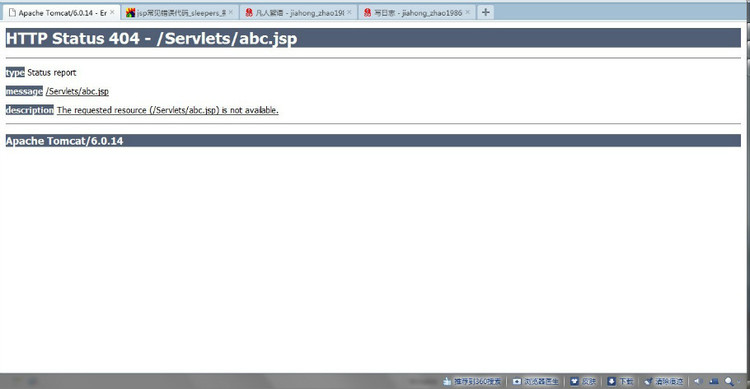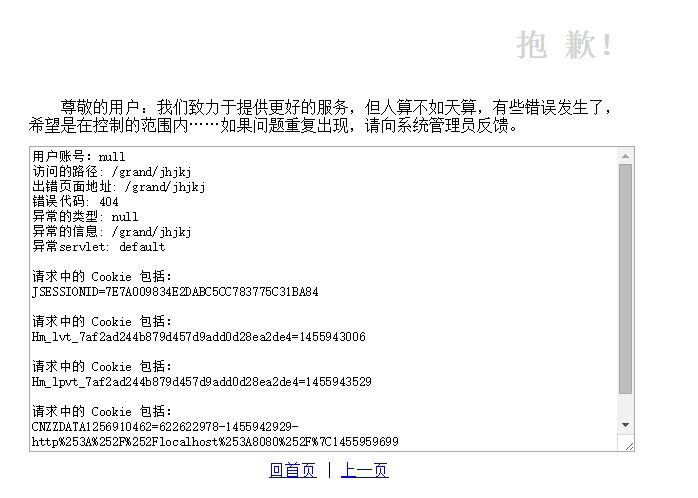發(fā)生服務器 500 異常,如果默認方式處理,則是將異常捕獲之后跳到 Tomcat 缺省的異常頁面,如下圖所示。

不論哪個網站都是一樣的,所以為了滿足自定義的需要,Tomcat 也允許自定義樣式的。也就是在 web.xml 文件中配置:
|
1
2
3
4
|
<error-page> <error-code>500</error-code> <location>/error.jsp</location> </error-page> |
首先說說自帶的邏輯。如果某個 JSP 頁面在執(zhí)行的過程中出現了錯誤, 那么 JSP 引擎會自動產生一個異常對象,如果這個 JSP 頁面指定了另一個 JSP 頁面為錯誤處理程序,那么 JSP 引擎會將這個異常對象放入到 request 對象中,傳到錯誤處理程序中。如果大家有寫 Servlet 的印象,這是和那個轉向模版 JSP 的 javax.servlet.forward.request_uri 一個思路,保留了原請求的路徑而不是 JSP 頁面的那個路徑。在錯誤處理程序里,因為 page 編譯指令的 isErrorPage 屬性的值被設為 true,那么 JSP 引擎會自動聲明一個 exception 對象,這個 exception 對象從 request 對象所包含的 HTTP 參數中獲得。
request 對象中包含的異常信息非常豐富,如下所示:

你可以用 Java 語句 request.getAttribute("javax.servlet.error.status_code") 獲取,也可以在 JSP 頁面中通過 EL 表達式來獲取,如 ${requestScope["javax.servlet.error.status_code"]}。
這個自定義錯誤頁面雖然簡單,JSP 本身也有很好的封裝結果,我也看過別人不少的資源,但細究之下也有不少“學問”,于是我想重新再”磨磨這個輪子“——首先 location 是一個 jsp 頁面,也可以是 servlet,不過萬一 servlet 也有可能啟動不起來的話那就使用簡單的 JSP 頁面就好了。我們通過 JSP 頁面定義內部類的方法,達到頁面與邏輯的分離(無須編寫 servlet)。其余的思路如下:
在 JSP 里面完成 ErrorHandler 類,另有頁面調用這個 ErrorHandler 類
不但可以接受 JSP 頁面的錯誤,也可接受 servlet 的控制器傳遞的錯誤,并且提取盡量多信息
全部內容先寫到內存,然后分別從兩個輸出流再輸出到頁面和文件
把錯誤信息輸出到網頁的同時,簡單加幾句話,可以把網頁上的信息也寫一份到數據庫或者文本
可以返回 HTML/JSON/XML
實現代碼如下:
|
1
2
3
4
5
6
7
8
9
10
11
12
13
14
15
16
17
18
19
20
21
22
23
24
25
26
27
28
29
30
31
32
33
34
35
36
37
38
39
40
41
42
43
44
45
46
47
48
49
50
51
52
53
54
55
56
57
58
59
60
61
62
63
64
65
66
67
68
69
70
71
72
73
74
75
76
77
78
79
80
81
82
83
84
85
86
87
88
89
90
91
92
93
94
95
96
97
98
99
100
101
102
103
104
105
106
107
108
109
110
111
112
113
114
115
116
117
118
119
120
121
122
123
124
125
126
|
/** * 異常處理類 */class ErrorHandler { // 全部內容先寫到內存,然后分別從兩個輸出流再輸出到頁面和文件 private ByteArrayOutputStream byteArrayOutputStream = new ByteArrayOutputStream(); private PrintStream printStream = new PrintStream(byteArrayOutputStream); /** * 收集錯誤信息 * @param request * @param exception * @param out */ public ErrorHandler(HttpServletRequest request, Throwable exception, JspWriter out) { setRequest(request); setException(exception); if(out != null) { try { out.print(byteArrayOutputStream); // 輸出到網頁 } catch (IOException e) { e.printStackTrace(); } } log(request); if(byteArrayOutputStream != null) try { byteArrayOutputStream.close(); } catch (IOException e) { e.printStackTrace(); } if(printStream != null) printStream.close(); } /** * * @param request */ private void setRequest(HttpServletRequest request) { printStream.println(); printStream.println("用戶賬號:" + request.getSession().getAttribute("userName")); printStream.println("訪問的路徑: " + getInfo(request, "javax.servlet.forward.request_uri", String.class)); printStream.println("出錯頁面地址: " + getInfo(request, "javax.servlet.error.request_uri", String.class)); printStream.println("錯誤代碼: " + getInfo(request, "javax.servlet.error.status_code", int.class)); printStream.println("異常的類型: " + getInfo(request, "javax.servlet.error.exception_type", Class.class)); printStream.println("異常的信息: " + getInfo(request, "javax.servlet.error.message", String.class)); printStream.println("異常servlet: " + getInfo(request, "javax.servlet.error.servlet_name", String.class)); printStream.println(); // 另外兩個對象 getInfo(request, "javax.servlet.jspException", Throwable.class); getInfo(request, "javax.servlet.forward.jspException", Throwable.class); Map<String, String[]> map = request.getParameterMap(); for (String key : map.keySet()) { printStream.println("請求中的 Parameter 包括:"); printStream.println(key + "=" + request.getParameter(key)); printStream.println(); } for (Cookie cookie : request.getCookies()){ // cookie.getValue() printStream.println("請求中的 Cookie 包括:"); printStream.println(cookie.getName() + "=" + cookie.getValue()); printStream.println(); } } /** * * @param exception */ private void setException(Throwable exception) { if (exception != null) { printStream.println("異常信息"); printStream.println(exception.getClass() + " : " + exception.getMessage()); printStream.println(); printStream.println("堆棧信息"); exception.printStackTrace(printStream); printStream.println(); } } /** * * @param request */ private void log(HttpServletRequest request) { File dir = new File(request.getSession().getServletContext().getRealPath("/errorLog")); if (!dir.exists()) { dir.mkdir(); } String timeStamp = new java.text.SimpleDateFormat("yyyyMMddhhmmssS").format(new Date()); File file = new File(dir.getAbsolutePath() + File.separatorChar + "error-" + timeStamp + ".txt"); // try(FileOutputStream fileOutputStream = new FileOutputStream(file); // PrintStream ps = new PrintStream(fileOutputStream)){// 寫到文件 // ps.print(byteArrayOutputStream); // } catch (FileNotFoundException e) { // e.printStackTrace(); // } catch (IOException e) { // e.printStackTrace(); // } catch (Exception e){ // e.printStackTrace(); // } } /** * * @param request * @param key * @param type * @return */ @SuppressWarnings("unchecked") private <T> T getInfo(HttpServletRequest request, String key, Class<T> type){ Object obj = request.getAttribute(key); return obj == null ? null : (T) obj; } } |
這樣就可以完成異常的控制了。下面定義 web.xml,讓 tomcat 出錯引向我們剛才指定的頁面 error.jsp
|
1
2
3
4
5
6
7
8
9
10
11
12
13
|
<!-- 404 頁面不存在錯誤 --> <error-page> <error-code>404</error-code> <location>/WEB-INF/jsp/common/default/error.jsp</location> </error-page> <!-- // --> <!-- 500 服務器內部錯誤 --> <error-page> <error-code>500</error-code> <location>/WEB-INF/jsp/common/default/error.jsp</location> </error-page> <!-- // --> |
我們安排一個默認的頁面如下

源碼如下:
|
1
2
3
4
5
6
7
8
9
10
11
12
13
14
15
16
17
18
19
20
21
22
23
24
25
26
27
28
29
30
31
32
33
34
35
36
37
38
39
40
41
42
|
<%@page pageEncoding="UTF-8" isErrorPage="true"%> <%@ include file="/WEB-INF/jsp/common/ClassicJSP/util.jsp"%> <!DOCTYPE html> <html> <head> <title>錯誤頁面</title> <style> body { max-width: 600px; min-width: 320px; margin: 0 auto; padding-top: 2%; } textarea { width: 100%; min-height: 300px; } h1 { text-align: right; color: lightgray; } div { margin-top: 1%; } </style> </head> <body> <h1>抱 歉!</h1> <div style="padding:2% 0;text-indent:2em;">尊敬的用戶:我們致力于提供更好的服務,但人算不如天算,有些錯誤發(fā)生了,希望是在控制的范圍內……如果問題重復出現,請向系統(tǒng)管理員反饋。</div> <textarea><% new ErrorHandler(request, exception, out); %></textarea> <div> <center> <a href="${pageContext.request.contextPath}">回首頁</a> | <a href="javascript:history.go(-1);">上一頁</a> </center> </div> </body> </html> |
以上就是本文的全部內容,希望對大家的學習有所幫助。













